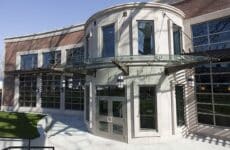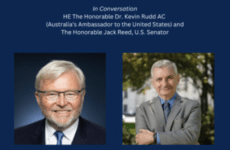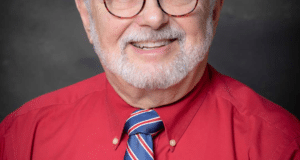By: Caroline Crosbie
Posted In: News

Photo credit: Caroline Crosbie
The Salve Regina University Archives hold the history of the official seal.
When looking for a buried treasure, one might only have to look as far as the Salve Regina University archives, located in Room 304 on the third floor of McKillop library.
Salve’s archivist, Maria Bernier, recently joined the Salve Regina community in September. “The primary mission for this part of the library is to collect the documents of the institution, preserve them, and make them accessible,” Bernier said. The archives contain documents that were used by or affiliated with Salve in any way and are now inactive. Salve Regina owns the copyright to all of the archives within its collection. “There were three archivists before me and they were all nuns,” Bernier said, “They have been collecting for 30 years.” The majority of the archives are property records of Salve’s lavish landscape. There are also minutes from meetings, course syllabi, faculty files, university publications, yearbooks, newspapers and directories. “Anyone who has taught a class, whether it was archery in the physical education department for one semester or a faculty member who worked here twenty years ago, it’s all here, ” Bernier said. The earliest archive in the Salve Regina collection dates back to the 1934 charter for Salve Regina College that was presented to the state of Rhode Island by the Sisters of Mercy. There was a large gap between the time when the charter was established and when Salve Regina was actually started in 1947. “These are important to the institution, they are our founding documents,” Bernier said. The latest piece of archives arrived within the last month and they are so new they sit unsorted in Bernier’s office in boxes. One box contains test results, student teaching records and evaluations from the Education department that date from 2002-2006. The other box holds the Cultural Historic Preservation plan which the University developed to maintain and preserve the architecture and buildings of Salve, according to Bernier. Bernier is in charge of developing policies for acquiring the archives, what should be kept and how the documents are sorted and preserved. Currently, they are kept in file folders inside filing cabinets. The archivists before her collected a lot of material, “but they did not develop processes for using the archives or what to collect,” Bernier said. The nuns duplicated a lot of the documents and Bernier said she is now trying to improve the archiving system and expand the collection. “In the future, I would like to start soliciting from alumni,” she said. If any alumni have journals of their time at Salve or alumni who have made it big in society, Bernier would like to have something from their collection added to Salve’s archives. The outlook for Salve’s historical documents also lies in digital technology. “What I’m hoping to do is streamline it, provide better documentation for where things are.” Once she is better organized, students will be able to use the computer to see what documents are in the archives. Only the more popular records will be uploaded, such as building information and property records, so it is easier for students and other researchers to use online. Many people have looked at Salve’s archive collection. Salve faculty, professors from other institutions and even the general public has contacted Bernier so that they may use the archives. “A woman from Spain was interested in a stained glass window in McAuley,” Bernier explained, “She wanted the letters written between the architect and the previous owner of McAuley.” Bernier said she works with students most of the time and they generally are Cultural Historic Preservation or Journalism majors. Rebecca Bertrand ’08, a Cultural Historic Preservation major used the archives in November. Bertrand said she was doing a landscape history project that involved surveying property in a historic district of Newport, including Salve Regina University property. Bertrand was in charge of Founders Hall and the property where the New Breakers Residence was. Bertrand used a Real Estate Ad from 1964 of Founders Hall, formally the Anthrope Estate, among other documents. “There were old photos of nuns; they were the founders of Salve. It was kind of cool. That’s what I was looking for, how it changed,” Bernier said. Bertrand plans on using the archives again, for any project in Cultural Historic Preservation when she needs research on a Salve building, mostly for architectural reasons. “It’s so easy for a Salve student to use and students rarely use it,” Bertrand said, “It’s interesting that it’s a constantly growing collection because it’s an institution collection.” Bertrand recommended using the archives when researching because it has better quality than any other resource. “We can all benefit from using it because it’s not published in books,” Bertrand said, “It’s really convenient.” These pieces of Salve’s history are easily accessible. “If students contact me in advance, that helps me figure out what the student is looking for in the archives.” Bernier can then pull out what documents the researcher may need and have it ready by appointment. To contact Maria Bernier, call her at 341-2276 or email her at maria.bernier@salve.edu. If someone wants to drop by and ask a question, she is in Room 304 on the third floor of McKillop library. “The purpose of the archives is to document Salve’s history and preserve it for future years,” Bernier said.













